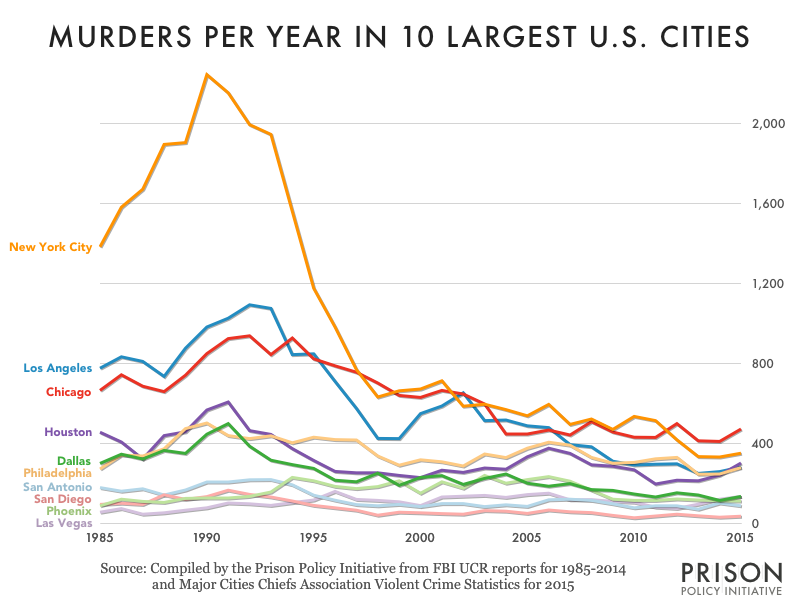Making a mountain out of a molehill: murder rate analysis
More and more people are talking about an uptick in murder and crime. Is there cause for alarm? No.
by Wendy Sawyer, September 8, 2016
More and more people are talking about an uptick in murder and crime. Is there cause for alarm?
No.
While murder is up in some cities, and in cities like Chicago significantly, there isn’t a crime wave and it’s certainly not being caused by the proliferation of citizens recording the police.
Looked at historically, murder is much less common than it used to be; and the small increase from 2014 to 2015 resembles the usual annual fluctuations. This minor change does not justify FBI Director James Comey’s declaration, “Holy cow do we have a problem” or Donald Trump’s tweet that “inner city crime is reaching record levels.”
The following chart shows that after a rapid drop in the 1990s, the number of murders in the U.S.’s ten largest cities have remained at or near record lows:
 For most cities, murder is much lower now than during the 1980s or 1990s. The data for 1985-2014 comes from the FBI. The FBI has not published the 2015 full year data yet, so I relied on data from the Major Cities Chiefs Association, which historically is very similar if slightly higher than the FBI’s figures. For that reason, this graph may overstate the increase in murder in 2015 in these cities.
For most cities, murder is much lower now than during the 1980s or 1990s. The data for 1985-2014 comes from the FBI. The FBI has not published the 2015 full year data yet, so I relied on data from the Major Cities Chiefs Association, which historically is very similar if slightly higher than the FBI’s figures. For that reason, this graph may overstate the increase in murder in 2015 in these cities.
While there is a notable rise in murder in Chicago (15% higher in 2015, and on track to exceed that in 2016), any discussion of the number of murders in Chicago needs to start with the fact that there have been half as many murders each year in the last decade than during the early 1990s.
It’s certainly true that a lot of major cities had increases in murder in 2015; but these were mostly small increases. In the historical view, murder remains at a record low.
Data sources: I compiled the totals for murder and non-negligent manslaughter from all agencies serving populations over 1,000,000 for 1985-2014 from the FBI UCR data. Data for 1985-2012 were available using the Data Tool, and totals for the same agencies for 2013 and 2014 were compiled from Crime in the United States 2013 and Crime in the United States 2014. Because the UCR full year report for 2015 has not yet been released, I used the totals published by the Major Cities Chiefs Association for 2015.



